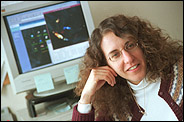Victoria Kaspi
Why does an astrophysicist, happily ensconced as an assistant professor in that Mecca of X-ray astronomy, the Massachusetts Institute of Technology, pack her bags for McGill, one of the continent's few research universities not to boast an astrophysics group?
 PHOTO: Owen Egan
PHOTO: Owen Egan |
|
"Because, the resources are excellent," says Victoria Kaspi, recently hired professor of physics and one of McGill's first Canada Research Chairs.
"This is a good time to be in Canada. There's lots of funding around."
Kaspi, for instance, received Canada Foundation for Innovation funding under the New Opportunities Program (designed to help young profs get their labs running) to establish a "multi-purpose pulsar processor." With one graduate student and two undergraduates, she will set up a computer, or set of computers, powerful enough to process the data she receives on her speciality: pulsars.
Beyond resources, however, are the opportunities provided by being at the beginning of something.
"It's nice to be part of a growing group," says Kaspi, who is her department's first full-fledged astrophysicist, although there are a least five other physics professors with "astro" research interests, she hastens to add.
"At MIT,it would have taken years before I would have had any say in who, for instance, would be hired for the astrophysics group," she continues. That won't be the case at McGill, where, Kaspi has just learned, Dean of Science Alan Shaver has given the go-ahead to hire another astrophysicist.
Family too, was a factor in Kaspi's decision to return to Montreal. After four years of a "commuting marriage," and the desire to begin a family settling in, Kaspi, who did her undergraduate degree in physics at McGill, liked the idea of living in the same city as her McGill cardiologist husband David Langleben, also a Montrealer.
And it's all worked out rather nicely for baby Ian, born last October only two months after his mother began at the University.
"Our families are a wonderful help to us," says Kaspi, who works several hours at home to top up her six-hour shift at McGill. That's how long one bottle of Kaspi's milk will do for Ian. "Do not enter, Am in 'cow mode. Will be done in 15 minutes," reads the sign Kaspi posts on her office door, when it's time to pump her milk.
On the same door is a photograph of Kaspi's other baby, a pulsar she recently helped date -- at least as accurately as one can date the formation of a star, 15,000 light years away -- with the help of NASA's Chandra X-ray Observatory satellite and her team of five, hailing from the United States, Japan and including McGill postdoctoral fellow Mallory Roberts.
Using the data collected by the satellite which receives the x-rays emitted by the tiny, neutron star, Kaspi and her team deduced that this pulsar could only be a "mere babe" of approximately 2,000 years, an age that places it "remarkably" close, in astronomical terms, to the explosion of a supernova, or giant star, observed in 386 AD by Chinese astrologers.
In 1997, when this pulsar -- one of the known 1,200 so-named because of their single beam of light which seems to pulsate with every one of its rapid rotations -- was discovered, it was estimated to be 24,000 years old by the Japanese Advanced Satellite for Cosmology and Astrophysics. However, that group didn't have the benefit of Chandra, launched only last year.
Kaspi and her team did and their dating of the pulsar attracted international attention when she presented the results earlier this month in San Diego at a meeting of the American Astronomical Society.
"We'll never know 100% what they [the Chinese] saw -- it could have been a comet -- but it all fits so nicely. You feel you have a connection to them," says Kaspi who spoke of her discovery to her students in the course Planets, Stars & Galaxies. "I think the Chinese would be delighted."

